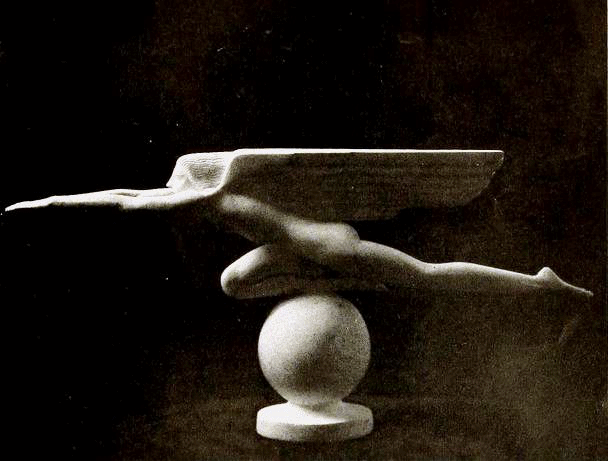Articles and Features
Art Movement: Art Deco

By Shira Wolfe
Art Deco is an art movement in visual arts, architecture, design and decorative arts that began emerging in France before the First World War, but really exploded in 1925. That year, in fact, the Exposition des Arts Décoratifs (Exhibition of Decorative Arts) was held in Paris, and artists, architects, and designers showed works in this style, thereby propelling the movement into the mainstream. Traversing different mediums, the style combined modern aesthetic with excellent craftsmanship and rich materials. The areas in which it dominated were architecture, design, clothing, jewellery, furniture and handicrafts. As such, the particular style became visible in all the layers of modern life.
Key period: 1925-1940
Key regions: Europe, United States
Key words: geometric forms, new materials, luxury, streamlined, decorative arts, applied, simplicity
Key artists: Tamara de Lempicka, Cassandre, Rene Buthaud, Raphael Delorme, Jean Gabriel Domergue, Jean Dupas, Paul Poiret, Sonia Delaunay, Raoul Dufy, Hector Guimard, Pierre Chareau, Francis Jourdain, Eugene Grasset

The origins of Art Deco
Although developed from Art Nouveau, Art Deco simultaneously represented a reaction against it by focusing on sharp geometric angles instead of the natural, organic forms Art Nouveau was infused with. Influenced by Cubism, the Vienna Secession, Fauvism and the aesthetics of the Ballets Russes, as well as styles from Eastern cultures, the style became beloved for its bold geometric forms, luxurious nature, and use of new materials, icons of modernity, such as aluminium, stainless steel, chrome and plastics.
As Francis Jourdain, one of the French artists who started the Societé des Artistes Décorateurs (The Society of Decorative Artists) explained, Art Deco challenged the hierarchical structure of the visual arts, which positioned decorative artists on a lower level than the more classical painting and sculpting media: “We consequently resolved to return decorative art, inconsiderately treated as a Cinderella or poor relation allowed to eat with the servants, to the important, almost preponderant place it occupied in the past, of all times and in all of the countries of the globe.” The group originally intended to create an exhibition presenting a new type of decorative art in 1914, but the plan had to be put on hold until after World War I ended. The exhibition was finally held in 1925 Paris over the course of six months. Over 16 million visitors saw the exhibition, which became the catalyst for the movement to take off. The name ‘Art Deco’ was first used pejoratively by the modernist architect Le Corbusier, who wrote a fierce article criticising the style for its ornamentation.

Art Deco across disciplines:
What was particularly notable about Art Deco was the fact that, like its predecessor Art Nouveau or movements like the Bauhaus, it was a functional style that was applied to all kinds of disciplines. The intention was to elevate the decorative arts to a higher position and its sleek, geometric style became a favourite in architecture, design, clothing, jewellery, furniture, and handicraft.
Art Deco Architecture
Cities around the world started to become the faces of Art Deco. From the New York skyscrapers to the London Underground, from Miami’s Art Deco district to Havana, Cuba, the port of Shanghai, and many neighbourhoods in Belgrade, Serbia, architecture worldwide boasted the streamlined, linear and geometric features. Beautiful reliefs and sculptures were often placed on these buildings, depicting figures with smooth chunky bodies and sharp angles and movement.

Art Deco Design and Fonts
The fascination with speed, machines and modern technology typical of the influence of Futurism, strongly influenced Art Deco design: “speed whiskers” would indicate movement, and parallel lines and tapering forms would suggest symmetry and streamline. The style extended as far as typography, with the typefaces Bifur, Broadway, and Peignot immediately familiar as Art Deco typefaces. Think of the letters on cinema’s from the 1920s and 1930s – the style was visible in the architecture, the design, and the typography.

Art Deco Furniture
Art Deco furniture combined expensive materials like ivory and silver inlays and luxurious wood, decorating the first-class salons of ocean liners, trains, skyscrapers and movie theatres. During the Great Depression, the style changed to suit the times and became soberer. However, the main characteristics remained the same. Both when done in the most luxurious manner, and when more pared down and sober, Art Deco stood out as a modern, sleek style.
Famous Art Deco artists
Tamara de Lempicka (1898-1980)
Although not so many painters are associated with this style, perhaps the most famous painter was Tamara de Lempicka. She exhibited in the 1925 Exhibition of Decorative Arts in Paris and soon after broke through with her characteristic “soft cubist” style that depicted elegant women in the 1920s and 1930s that truly became the image of a generation. She firmly believed that her paintings – just like the movement in all its other incarnations – would always stand out with their distinctive, attractive style.

Paul Poiret (1879-1944)
In fashion, Paul Poiret was one of the most famous designers incorporating Art Deco into his innovative work. He introduced the concept of draping and designing clothing cut along straight lines and constructed of rectangular motifs, paving the way for a more practical and streamlined fashion.
Decline of Art Deco
The movement fell out of fashion during the Second World War. In these austere times, people felt the style was overly decadent. Metals were being salvaged to use for constructing armaments, as opposed to decorating buildings or interior spaces, and furnishings were no longer considered status objects. However, many of the great Art Deco buildings still remain standing, and the movement gained renewed interest in the 1960s and is again extremely popular today.
Relevant sources to learn more
Art Movements and Styles Throughout History
Fritz Lang’s Metropolis. How the iconic silent film took inspiration from art movements
Tate

